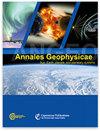利用 EISCAT_3D 进行干涉成像,以测量细尺度光束内不相干散射光谱
IF 1.9
4区 地球科学
Q3 ASTRONOMY & ASTROPHYSICS
引用次数: 0
摘要
摘要目前正在芬诺斯坎迪亚北部建造的 233 MHz EISCAT_3D 雷达系统将能够通过使用干涉成像技术来分辨小于发射波束尺寸的电离层结构。这种能力得益于模块化设计和位于斯基博特恩主站点的 119 个 91 天线面板的数字化。主阵列由一组 109 个面板组成,其中 10 个离群面板产生独特的干涉测量基线。在本研究中,合成非相干散射雷达信号测量值被用于 EISCAT_3D 系统的干涉成像分析。利用离子-中性相互作用地球空间环境模型(GEMINI)以 50 米的分辨率模拟尖顶区域的开尔文-赫尔姆霍兹不稳定性,以获得等离子体参数,然后用于生成合成数据。电离层数据被前传到 EISCAT_3D 阵列,噪声被添加到合成数据中,然后对数据进行反演,以重建相对精细尺度的非相干散射谱。通过使用带 Tikhonov 正则化的奇异值分解(SVD),可以预先计算特定范围和观测方向的反演矩阵,正则化值根据信噪比缩放。反演矩阵的预计算可减少成像解决方案的计算开销。这项研究为离子线非相干散射雷达光谱的数据处理提供了一个框架,以便在精细尺度上成像。此外,经过进一步开发,它还可用于测试实验装置,并通过研究各种信噪比、波束模式和电离层条件下所需的积分时间,为 EISCAT_3D 设计实验。本文章由计算机程序翻译,如有差异,请以英文原文为准。
Interferometric Imaging with EISCAT_3D for Fine-Scale In-Beam Incoherent Scatter Spectra Measurements
Abstract. The 233 MHz EISCAT_3D radar system currently under construction in northern Fennoscandia will be able to resolve ionospheric structures smaller than the transmit beam dimensions through the use of interferometric imaging. This capability is made possible by the modular design and digitisation of the 119 91-antenna panels located at the main Skibotn site. The main array consists of a cluster of 109 panels, with 10 outlier panels producing unique interferometry baselines. In the present study synthesized incoherent scatter radar signal measurements are used for interferometric imaging analysis with the EISCAT_3D system. The Geospace Environment Model of Ion-Neutral Interactions (GEMINI) model is used to simulate a Kelvin-Helmholtz instability in the cusp region at 50 m resolution to obtain plasma parameters which are then used to generate the synthetic data. The ionospheric data is forward propagated to the EISCAT_3D array, noise is added to the synthetic data, and then an inversion of the data is performed to reconstruct the incoherent scatter spectra at relatively fine scales. By using Singular Value Decomposition (SVD) with Tikhonov regularization it is possible to pre-calculate the inversion matrix for a given range and look direction, with the regularization value scaled based on the SNR. The pre-calculation of the inversion matrix can reduce computational overhead in the imaging solution. This study provides a framework for data processing of ion-line incoherent scatter radar spectra to be imaged on fine-scales. Furthermore, with more development it can be used to test experimental set-ups and to design experiments for EISCAT_3D by investigating the needed integration time for various signal-to-noise ratios, beam patterns and ionospheric conditions.
求助全文
通过发布文献求助,成功后即可免费获取论文全文。
去求助
来源期刊

Annales Geophysicae
地学-地球科学综合
CiteScore
4.30
自引率
0.00%
发文量
42
审稿时长
2 months
期刊介绍:
Annales Geophysicae (ANGEO) is a not-for-profit international multi- and inter-disciplinary scientific open-access journal in the field of solar–terrestrial and planetary sciences. ANGEO publishes original articles and short communications (letters) on research of the Sun–Earth system, including the science of space weather, solar–terrestrial plasma physics, the Earth''s ionosphere and atmosphere, the magnetosphere, and the study of planets and planetary systems, the interaction between the different spheres of a planet, and the interaction across the planetary system. Topics range from space weathering, planetary magnetic field, and planetary interior and surface dynamics to the formation and evolution of planetary systems.
 求助内容:
求助内容: 应助结果提醒方式:
应助结果提醒方式:


